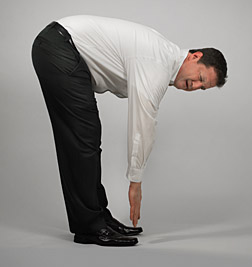Being able to touch your toes is about a common barometer and ultimate goal for back health as there has ever been. In modern postural yoga the pose that involves folding the torso over straightened legs has a name, uttanasana – from the Sanskrit for “intense stretch.”

uttanasana – standing forward bend
But what exactly is it that is (supposed to be) intensely stretching? Some describe this pose as a spinal stretch, which in various photos (as above) presumes the ability of the knees and hamstrings to be able to fully extend, with the leg muscles taut. A kind of freedom of movement between torso and trunk and the core muscles that connect the former to the latter will allow for this deep lengthening of the vertebrae and the muscles that support the spine.
But for many, the full expression of uttanasana – the standing forward bend remains elusive, a distant if not impossible goal (or so we think). We are taught to safely lengthen the spine by releasing or bending the knees in the pose. So we soften the core muscles, protect the hamstrings and the lumbar spine while getting the intense stretch across the back.
For many of us – but especially a certain male demographic – the pose more likely resembles this:

Why? A few possibilities:
- We are not in the habit of stretching, or moving mindfully.
- We are not aware of common postural habits in the way we sit, stand and walk.
- We’ve neglected our core muscles, either through gradual loss of a consistent fitness routine, or through over-emphasis on work in the periphery vs. the core.
Sitting as we do – in cars and office chairs and on couches – shortens and weakens the core muscles, forcing the back muscles to do the bulk of the work that supports the spine. If the back has to work more, it will contract and remain tight. When the back muscles are tight – in near constant contraction – they pull up on the hips and pelvis, which is why many people often have painful tightness around the outer hips as well as in the back.
So learning to touch your toes is not just about hamstrings. It’s about belly and back and hips, too. And when trying to fold forward from a standing position with straight knees, tight back muscles aren’t getting the lengthening, safe stretch they need. The back rounds, the belly muscles stay short. The tight back continues to pull up on the tight hip, pelvic and leg muscles.
One simple method for gauging hamstring tightness without compromising the back is to lie on your back near a doorway. Lie with the right leg extended on the ground – through the door – and place the left heel on the wall of the doorway, just to the left of the opening. We’ll be moving toward getting the back of the left leg – with a straight knee – fully on the wall. But when the core, back and hips are locked up, this will not be initially available, probably not even close.
Next, move to a mat have a long strap handy. With the right leg extended on the ground, put the middle of the strap around the ball of the left foot and take the leg away from the ground, taking a length of strap in each hand. Try to bring the shoulders and elbows to the ground. Lift through the heel and try to straighten the knee, angling the leg away from ninety degrees as much as necessary. Firm the quadriceps muscles on the top of the thigh and lengthen the inner hamstrings away from the body, away from the hips, pressing through the big toe knuckle (rather more than the pinkie toe knuckle). Feel the belly of the hamstring muscles stretch. Feel this lengthening in the body of the muscle, not just at the points of connection to the knee or the hip.
Take 5-8 breaths here, allowing a slight release of the hold on the inhalation, and a deepening stretch and extension on the exhalation. Breathe slowly and completely and take care not to push into pain. Back off and release the knee joint slightly if the breath or your expression (are you grimacing?) becomes compromised. After 5-8 breaths, release the strap, take it onto the ball of the right foot and repeat the sequence.
No back muscles are used in this modified reclined hand to big toe pose (supta padangusthasana if you like the Sanskrit), and we let the hamstrings lengthen safely by keeping the quadriceps muscles engaged. This pose, when practiced regularly and frequently as part of a sequence that also opens and the stretches the hips and back and strengthens the core, will move you toward a safe, strong spine-extending forward bend in good time.
Note: Structural imbalances in the spine, vertebral compression, herniated disks and other spinal issues should always be diagnosed and treated by a licensed physician. Yoga can help stabilize the spine in some instances of spinal distress, but some postures also be contraindicated under certain circumstances.